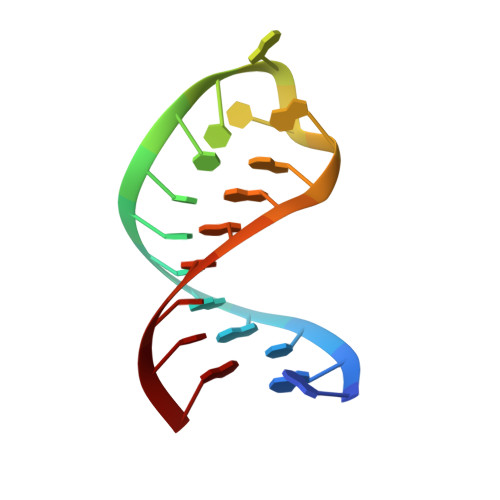NMR Structure of the 3' Stem-Loop from Human U4 snRNA
Comolli, L.R., Ulyanov, N.B., Soto, A.M., Marky, L.A., James, T.L., Gmeiner, W.H.(2002) Nucleic Acids Res 30: 4371-4379
- PubMed: 12384583
- DOI: https://doi.org/10.1093/nar/gkf560
- Primary Citation of Related Structures:
1MFJ - PubMed Abstract:
The NMR structure of the 3' stem-loop (3'SL) from human U4 snRNA was determined to gain insight into the structural basis for conservation of this stem-loop sequence from vertebrates. 3'SL sequences from human, rat, mouse and chicken U4 snRNA each consist of a 7 bp stem capped by a UACG tetraloop. No high resolution structure has previously been reported for a UACG tetraloop. The UACG tetraloop portion of the 3'SL was especially well defined by the NMR data, with a total of 92 NOE-derived restraints (about 15 per residue), including 48 inter-residue restraints (about 8 per residue) for the tetraloop and closing C-G base pair. Distance restraints were derived from NOESY spectra using MARDIGRAS with random error analysis. Refinement of the 20mer RNA hairpin structure was carried out using the programs DYANA and miniCarlo. In the UACG tetraloop, U and G formed a base pair stabilized by two hydrogen bonds, one between the 2'-hydroxyl proton of U and carbonyl oxygen of G, another between the imino proton of G and carbonyl oxygen O2 of U. In addition, the amino group of C formed a hydrogen bond with the phosphate oxygen of A. G adopted a syn orientation about the glycosidic bond, while the sugar puckers of A and C were either C2'-endo or flexible. The conformation of the UACG tetraloop was, overall, similar to that previously reported for UUCG tetraloops, another member of the UNCG class of tetraloops. The presence of an A, rather than a U, at the variable position, however, presents a distinct surface for interaction of the 3'SL tetraloop with either RNA or protein residues that may stabilize interactions important for active spliceosome formation. Such tertiary interactions may explain the conservation of the UACG tetraloop motif in 3'SL sequences from U4 snRNA in vertebrates.
Organizational Affiliation:
Department of Pharmaceutical Chemistry, University of California at San Francisco, San Francisco, CA 94143, USA.














